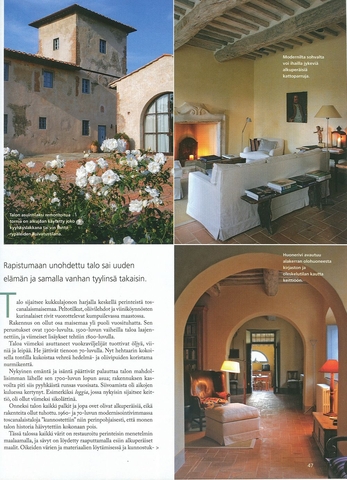
The house is situated on a top of a line of hills – and surrounded by the most idyllic Tuscan scenery. Fields, olive groves and vine yards succeed one after another in the gently rolling terrain.
The building has been part of this scenery for centuries, as its foundations date back as early as the fourteenth century. It was extended in the mid-sixteenth century, and the last rooms were added in the nineteenth century.
The last peasants to occupy the farmhouse produced olive oil, wine and bread, and they left the place in the 1970s. Now the garden encircling the house has been reduced to a hectare, and it is adorned by olive and fruit trees.
The present owners decided to return the house in its late-eighteenth century outlook – which, in reality, meant to wipe off more than a century of its history. A big part of the restoration was nothing but cleaning; the loggia for example, where the kitchen nowadays is, used to be a piggery.
The house is situated on a top of a line of hills – and surrounded by the most idyllic Tuscan scenery. Fields, olive groves and vine yards succeed one after another in the gently rolling terrain.
The building has been part of this scenery for centuries, as its foundations date back as early as the fourteenth century. It was extended in the mid-sixteenth century, and the last rooms were added in the nineteenth century.
The last peasants to occupy the farmhouse produced olive oil, wine and bread, and they left the place in the 1970s. Now the garden encircling the house has been reduced to a hectare, and it is adorned by olive and fruit trees.
The present owners decided to return the house in its late-eighteenth century outlook – which, in reality, meant to wipe off more than a century of its history. A big part of the restoration was nothing but cleaning; the loggia for example, where the kitchen nowadays is, used to be a piggery.
Fortunately much of the building (beams and doors included) were in its original state, and the old floor plan had not been destroyed. That had been the fate of many Tuscan farmhouses in the 1960s and 1970s: their owners sought to “modernize” their houses so thoroughly that they ended up erasing centuries of history.
All the original colours have been brought back by using traditional painting methods, and the owners found the right shades after the painters had scraped layers of old paint from the walls. In all this an essential help was a Roman interior designer Andrea Gobbi, who ensured that the restoration was historically correct. Gobbi has always been particularly interested in Tuscan architecture, and his works has been shown in magazines such as Elle Décor and House&Garden.
|